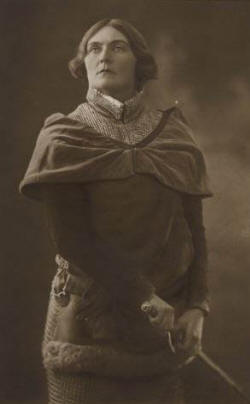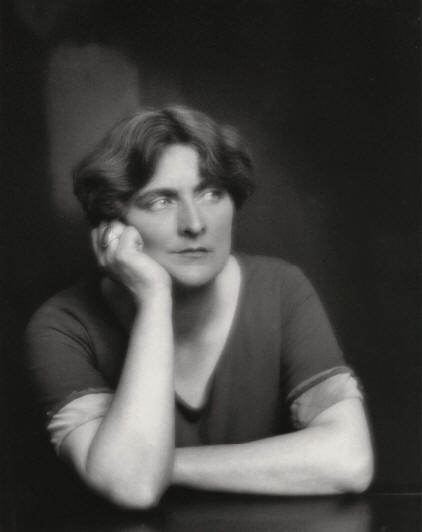

Queer Places:
Thorndikes, 60 St Margaret's St, Rochester ME1 1UJ, UK
6 Carlyle Square, Chelsea, London SW3 6EX
Swan Court, Chelsea Manor Street, Chelsea SW3 5RT,
UK
University of Oxford, Oxford, Oxfordshire OX1 3PA
Westminster Abbey
Westminster, City of Westminster, Greater London, England
 Dame
Agnes Sybil Thorndike CH DBE (24 October 1882 – 9 June 1976) was an English
bisexual actress who toured internationally in Shakespearean productions,
often appearing with her husband Lewis Casson. Bernard Shaw wrote Saint
Joan specially for her, and she starred in it with great success. She was
made Dame Commander of the Order of the British Empire in 1931, and Companion
of Honour in 1970.
Emma Goldman contacted her in London for help arranging benefit performance for CNT-FAI; with
Goldman and Rebecca West, she established the Committee to Aid Homeless
Spanish Women and Children.
Dame
Agnes Sybil Thorndike CH DBE (24 October 1882 – 9 June 1976) was an English
bisexual actress who toured internationally in Shakespearean productions,
often appearing with her husband Lewis Casson. Bernard Shaw wrote Saint
Joan specially for her, and she starred in it with great success. She was
made Dame Commander of the Order of the British Empire in 1931, and Companion
of Honour in 1970.
Emma Goldman contacted her in London for help arranging benefit performance for CNT-FAI; with
Goldman and Rebecca West, she established the Committee to Aid Homeless
Spanish Women and Children.
Thorndike was born in Gainsborough, Lincolnshire, the eldest of the four children of Agnes Macdonald, daughter of ship engineer John Bowers, and Reverend Arthur John Webster Thorndike (1853–1917). When she was two years old her father was appointed a minor canon of Rochester Cathedral.[3] She was educated at Rochester Grammar School for Girls, and first trained as a classical pianist, making weekly visits to London for music lessons at the Guildhall School of Music and Drama.[4][5]
HHer childhood home in Rochester has been renamed after her.[6] She gave her first public performance as a pianist at the age of 11, but in 1899 was forced to give up playing owing to piano cramp. At the instigation of her brother, the author Russell Thorndike, she then trained as an actress under Elsie Fogerty at the Central School of Speech and Drama, then based at the Royal Albert Hall, London.[7]
At the age of 21 she was offered her first professional contract: a tour of the United States with the actor-manager Ben Greet's company. She made her first stage appearance in Greet's 1904 production of Shakespeare's The Merry Wives of Windsor. She went on to tour the U.S. in Shakespearean repertory for four years, playing some 112 roles.[8]
In 1908, she was spotted by the playwright George Bernard Shaw when she understudied the leading role of Candida in a tour directed by Shaw himself. There she also met her future husband, Lewis Casson. They were married in December 1908, and had four children: John (1909–1999), Christopher (1912–1996), Mary (1914–2009), and Ann (1915–1990). She was survived by her four children and a number of grandchildren and great-grandchildren when she died.

Sybil Thorndike
by Lewis Morley
toned bromide print, 1960s
15 1/2 in. x 11 1/2 in. (395 mm x 293 mm)
Given by Lewis Morley, 1989
Photographs Collection
NPG x125238

Sybil Thorndike in 'Granite'
by Paul Tanqueray
vintage bromide print, 1926
9 1/2 in. x 7 1/2 in. (240 mm x 192 mm)
Given by Paul Tanqueray, 1975
Photographs Collection
NPG x26871

'Sybil' (Hannen Swaffer; Sybil Thorndike; George Bernard Shaw and four unknown sitters)
by Mark Wayner (Weiner)
lithograph, published 1931
14 5/8 in. x 10 in. (371 mm x 254 mm) paper size
Purchased, 2006
Reference Collection
NPG D23322
She joined Annie Horniman's company in Manchester (1908–1909 and 1911–1913), went to Broadway in 1910, and then joined the Old Vic Company in London (1914–1918), playing leading roles in Shakespeare and in other classic plays. After the First World War, she played Hecuba in Euripides The Trojan Women (1919–1920), then from 1920 to 1922 Thorndike and her husband starred in a British version of France's Grand Guignol directed by Jose Levy.[9] She was a Soroptimist and a Founder Member of SI Greater London Club, which was chartered in 1923.
She returned to the stage in the title role of George Bernard Shaw's Saint Joan in 1924, which had been written with her specifically in mind. The production was a huge success, and was revived repeatedly until her final performance in the role in 1941. In 1927, Thorndike appeared in a short film of the cathedral scene from Saint Joan made in the DeForest Phonofilm sound-on-film process. Both Thorndike and Casson were active members of the Labour Party, and held strong left-wing views. Even when the 1926 General Strike stopped the first run of Saint Joan, they both still supported the strikers.[10]
She was made a Dame Commander of the Order of the British Empire in 1931. As a pacifist, Thorndike was a member of the Peace Pledge Union and gave readings for its benefit. During the Second World War, Thorndike and her husband toured in Shakespearean productions on behalf of the Council For the Encouragement of the Arts, before joining Laurence Olivier and Ralph Richardson in the Old Vic season at the New Theatre in 1944.[11]
At the end of the Second World War, it was discovered that Thorndike was on "The Black Book" or Sonderfahndungsliste G.B. list of Britons who were to be arrested in the event of a Nazi invasion of Britain.[12]
She continued to have success in such plays as N. C. Hunter's Waters of the Moon at the Haymarket in 1951–52. In 1953 she was performing in a new play, A Day by the Sea, when the press revealed that her co-star John Gielgud had been fined for homosexual activity.[13] Thorndike "staunchly championed" Gielgud, as did most theatre audiences: the play was warmly received both in Liverpool and the Haymarket.[14]
She also undertook tours of Australia and South Africa, before playing again with Olivier in Uncle Vanya at Chichester in 1962. She made her farewell appearance with her husband in a London revival of Arsenic and Old Lace at the Vaudeville Theatre in 1966. Her last stage performance was at the Thorndike Theatre in Leatherhead, Surrey, in There Was an Old Woman in 1969, the year Lewis Casson died.[15]
Her final acting appearance was in a TV drama The Great Inimitable Mr. Dickens, with Anthony Hopkins in 1970. That same year she was made a Companion of Honour. She and her husband (who was knighted in 1945) were one of the few couples who both held titles in their own right. She was also awarded an honorary degree from the University of Manchester in 1922 and an honorary Doctor of Letters degree from the University of Oxford in 1966.
She died at her flat in London on 9 June 1976.[3] Her ashes are buried in Westminster Abbey.
My published books:
https://en.wikipedia.org/wiki/Sybil_Thorndike